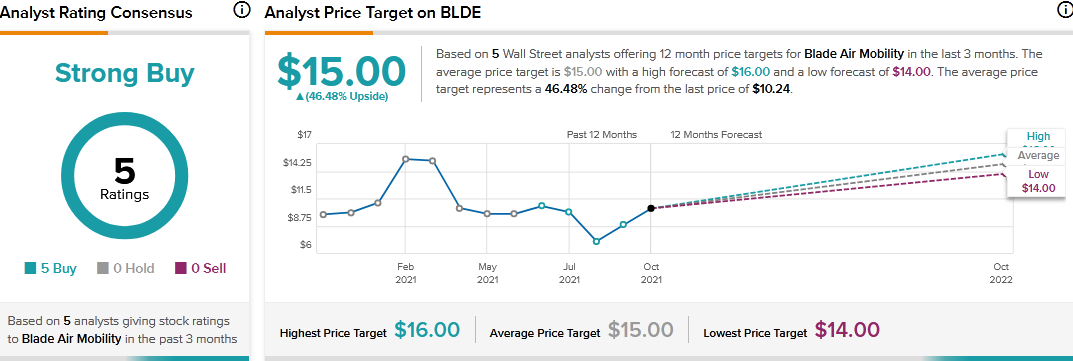Blade Air Mobility (BLDE) operates a global air mobility platform. It transports people in helicopters and jets, helping users avoid congested ground routes in large cities.
Protect Your Portfolio Against Market Uncertainty
- Discover companies with rock-solid fundamentals in TipRanks' Smart Value Newsletter.
- Receive undervalued stocks, resilient to market uncertainty, delivered straight to your inbox.
Let’s take a look at the company’s latest financial performance, corporate updates, and newly added risk factors. (See Blade stock charts on TipRanks)
Fiscal Q3 Financial Results
Blade reported revenue of $13 million for its Fiscal 2021 third-quarter ended June 30. That compared to $3.4 million in the same quarter last year. The company’s net loss widened to $24.3 million from $1.3 million a year ago. Blade ended Q3 with $333 million in cash, which will support route expansions and acquisitions.
Corporate Updates
Blade has completed the $23 million acquisition of Arizona-based organ logistics company Trinity Air Medical. Trinity partners with organizations that procure organs and centers that perform organ transplants. Its goal is to maximize organ availability across the U.S. for transplant needs. Trinity generated revenue of $1.6 million in 2020 and the business is already profitable. Blade expects the Trinity acquisition to accelerate revenue growth in its MediMobility division and transform it into the largest U.S.-dedicated provider of organ air transport.
Blade continues to sign more electric aircraft partners. It recently signed Embraer Eve and magniX, bringing its electric virtual aircraft manufacturer alliances to four. The other partners are Wisk Aero and Beta Technologies. Blade said the partnerships represent milestones in its transition to electric aircraft.
Risk Factors
The new TipRanks Risk Factors tool shows 55 risk factors for Blade. Since March 2021, the company has updated its risk profile to remove 62 old risk factors and introduce 49 new risk factors.
In a newly added risk factor, the company tells investors that its stock price may decline and existing shareholders’ stakes may be diluted because it may sell additional shares in the future.
Blade says in another new risk factor that it has started expanding internationally. For example, it entered India through a joint venture arrangement in 2019. The company cautions that international expansion may lead it to incur significant additional costs, and that its plans may fail.
Further, the company tells investors in a newly added risk factor that its operations are concentrated in a small number of airports and metro areas. It warns that such concentration makes its business susceptible to natural disasters and economic conditions that affect metropolitan areas.
Blade removed the risk factors cautioning investors that its plans to go public through a merger with a special purpose acquisition company could run into challenges.
The majority of Blade’s risk factors fall under the Finance and Corporate category, with 44% of the total risks. That is above the sector average of 39%. Blade’s stock price has declined about 8 percent year-to-date.

Analysts’ Take
Following the closing of the Trinity acquisition, Deutsche Bank analyst Hillary Cacanando reiterated a Buy rating on Blade stock with a price target of $15. Cacanando’s price target suggests 46.48% upside potential.
The analyst noted that Blade intends to complete two accretive acquisitions in the next few months. With the Trinity deal complete, Cacanando expects the second acquisition to drive Blade’s stock higher.
Consensus among analysts is a Strong Buy based on 5 Buys. The average Blade price target of $15 implies 46.48% upside potential to current levels.

Related News:
Levi’s Beats Q3 Expectations; Shares Pop After-Hours
Autodesk Prices Inaugural $1B Sustainability Bond Offering; Street Says Buy
Fubo Gaming, Cleveland Cavaliers Announce Partnership; Street Says Buy
















